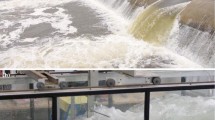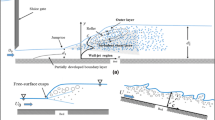Abstract
A physical study of hydraulic jump is often undertaken using down-scaled Froude-similar models with Reynolds numbers much smaller than in prototype (e.g. spillway stilling basins). The potential viscous scale effects may affect a number of physical processes including turbulence development and air entrainment, thus challenging the extrapolation of laboratory data to the prediction of prototype conditions or justification of numerical modelling. This paper presents an experimental study of hydraulic jumps with a particular focus on the scale effects in terms of free-surface fluctuation and deformation, bubble advection and diffusion, bubble-turbulence interaction and turbulence dissipation. A broad range of free-surface, air–water flow and turbulence properties were measured systematically for Froude numbers from 3.8 to 10 and Reynolds numbers from 2.1 × 104 to 1.6 × 105. Based upon self-similarities in the longitudinal evolution of a number of characteristic flow properties, the analytical expressions of time-averaged roller surface profile, void fraction distribution and longitudinal velocity distribution were derived for given Froude number. The roller surface dynamics were found free of scale effects in terms of fluctuation amplitudes but the characteristic frequencies were scale-sensitive. While some air–water flow parameters such as bubble count rate, bubble chord time distribution and bubble grouping behaviour could only be correctly quantified at full-scale prototype conditions, the aeration level and turbulent scales might be estimated with satisfactory accuracy for engineering applications given a model Reynolds number no less than 4 × 10 to 6 × 104.













Similar content being viewed by others
References
Barenblatt GI (1996) Scaling, self-similarity, and intermediate asymptotics. Cambridge University Press, UK
Bélanger JB (1841) Notes sur l’hydraulique (Notes on hydraulic engineering). Ecole Royale des Ponts et Chaussées, Paris (in French)
Bidone G (1819) Le remou et sur la propagation des ondes (The jump and on the wave propagation). Rep R Acad Sci Turin 12:21–112 (in French)
Bin AK (1993) Gas entrainment by plunging liquid jets. Chem Eng Sci 48(21):3585–3630
Brattberg T, Chanson H (1998) Air entrainment and air bubble dispersion at two-dimensional plunging water jets. Chem Eng Sci 53(24):4113–4127
Brattberg T, Chanson H, Toombes L (1998) Experimental investigations of free-surface aeration in the developing flow of two-dimensional water jets. J Fluid Eng 120(4):738–744
Cain P, Wood IR (1981) Measurements of self-aerated flow on spillways. J Hydraul Division 107(HY11):1425–1444
Chachereau Y, Chanson H (2011) Bubbly flow measurements in hydraulic jumps with small inflow Froude numbers. Int J Multiph Flow 37(6):555–564. doi:10.1016/j.ijmultiphaseflow.2011.03.012
Chanson H (2010) Convective transport of air bubbles in strong hydraulic jumps. Int J Multiph Flow 36(10):798–814. doi:10.1016/j.ijmultiphaseflow.2010.05.006
Chanson H, Chachereau Y (2013) Scale effects affecting two-phase flow properties in hydraulic jump with small inflow Froude number. Exp Therm Fluid Sci 45:234–242. doi:10.1016/j.expthermflusci.2012.11.014
Chanson H, Gualtieri C (2008) Similitude and scale effects of air entrainment in hydraulic jumps. J Hydraul Res 46(1):35–44
Chanson H, Toombes L (2002) Air-water flows down stepped chutes: turbulence and flow structure observations. Int J Multiph Flow 28(11):1737–1761
Coakley DB, Haldeman PM, Morgan DG, Nicolas KR, Penndorf DR, Wetzel LB, Weller CS (2001) Electromagnetic scattering from large steady breaking waves. Exp Fluids 30:479–487
Hager WH (1992) Energy dissipators and hydraulic jump. Kluwer Academic Publishers, Dordrecht
Henderson FM (1966) Open channel flow. MacMillan Company, New York
Hoyt JW, Sellin RHJ (1989) Hydraulic jump as ‘mixing layer’. J Hydraul Eng 40(3):1607–1614
Kucukali S, Chanson H (2008) Turbulence measurements in hydraulic jumps with partially-developed inflow conditions. Exp Therm Fluid Sci 33(1):41–53. doi:10.1016/j.expthermflusci.2008.06.012
Liggett JA (1994) Fluid mechanics. McGraw-Hill, New York
Lighthill J (1978) Waves in fluid. Cambridge University Press, Cambridge
Lin C, Hsieh S, Lin I, Chang K, Raikar R (2012) Flow property and self-similarity in steady hydraulic jumps. Exp Fluids 53:1591–1616. doi:10.1007/s00348-012-1377-2
Liu M, Rajaratnam N, Zhu D (2004) Turbulent structure of hydraulic jumps of low Froude numbers. J Hydraul Eng 130(6):511–520
Long D, Rajaratnam N, Steffler PM, Smy PR (1991) Structure of flow in hydraulic jumps. J Hydraul Res 29(2):207–218
Montes SJ (1998) Hydraulics of open channel flow. ASCE Press, New York
Murzyn F, Chanson H (2008) Experimental assessment of scale effects affecting two-phase flow properties in hydraulic jumps. Exp Fluids 45(3):513–521. doi:10.1007/s00348-008-0494-4
Murzyn F, Chanson H (2009) Experimental investigation of bubbly flow and turbulence in hydraulic jumps. Environ Fluid Mech 9(2):143–159. doi:10.1007/s10652-008-9077-4
Murzyn F, Mouaze D, Chaplin JR (2005) Optical fibre probe measurements of bubbly flow in hydraulic jumps. Int J Multiph Flow 31(1):141–154. doi:10.1016/j.ijmultiphaseflow.2004.09.004
Murzyn F, Mouaze D, Chaplin JR (2007) Air-water interface dynamic and free surface features in hydraulic jumps. J Hydraul Res 45(5):679–685. doi:10.1080/00221686.2007.9521804
Prosperetti A, Tryggvason G (2009) Computational methods for multiphase flow. Cambridge University Press, London
Rajaratnam N (1962) An experimental study of air entrainment characteristics of the hydraulic jump. J Instr Eng India 42(7):247–273
Rajaratnam N (1965) The hydraulic jump as a wall jet. J Hydraul Div 91(HY5):107–132
Resch FJ, Leutheusser HJ (1972) Le ressaut hydraulique: mesures de turbulence dans la région diphasique (The hydraulic jump: turbulence measurements in the two-phase flow region). La Houille Blanche 4:279–293 (in French)
Richard GL, Gavrilyuk SL (2013) The classical hydraulic jump in a model of shear shallow-water flows. J Fluid Mech 725:492–521. doi:10.1017/jfm.2013.174
Subramanya K (2009) Flow in open channels. Tata McGraw-Hill Education, New Delhi
Svendsen IA, Veeramony J, Bakunin J, Kirby JT (2000) The flow in weak turbulent hydraulic jumps. J Fluid Mech 418:25–57
Wang H (2014) Turbulence and air entrainment in hydraulic jumps. PhD thesis. School of Civil Engineering, The University of Queensland, Brisbane. doi: 10.14264/uql.2014.542
Wang H, Felder S, Chanson H (2014) An experimental study of turbulent two-phase flow in hydraulic jumps and application of a triple decomposition technique. Exp Fluids 55(7):1775. doi:10.1007/s00348-014-1775-8
Wood IR (1991) Air entrainment in free-surface flows. IAHR Hydraulic Structures Design Manual No. 4, Hydraulic Design Considerations. Balkema Publisher, Rotterdam
Acknowledgments
The authors thank Jason Van Der Gevel and Stewart Matthews, School of Civil Engineering, The University of Queensland for their technical assistance. The post-processing of phase-detection probe signal was facilitated by the software developed by Dr Stefan Felder (University of New South Wales). The research project was supported by the Australian Research Council (Grant DP120100481). The first author acknowledges the advisory input of Dr Frédéric Murzyn (ESTACA Laval, France) during his Ph.D. thesis.
Author information
Authors and Affiliations
Corresponding author
Rights and permissions
About this article
Cite this article
Wang, H., Chanson, H. Self-similarity and scale effects in physical modelling of hydraulic jump roller dynamics, air entrainment and turbulent scales. Environ Fluid Mech 16, 1087–1110 (2016). https://doi.org/10.1007/s10652-016-9466-z
Received:
Accepted:
Published:
Issue Date:
DOI: https://doi.org/10.1007/s10652-016-9466-z




